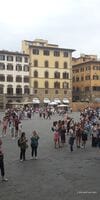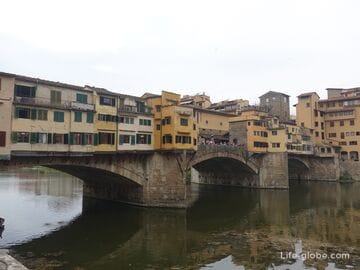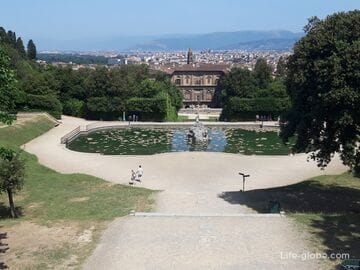Signoria Square (Piazza della Signoria) is one of the main and most visited squares of the historical center of Florence, where the sights of the city are concentrated, there are palaces, museums, a fountain, statues and sculptures.
The first finds on the square date back to the Neolithic period; and the square was an important area of the Roman city. At various times there were baths, artisans' houses and a church on the square.
The square began to acquire its current appearance around 1268. After the construction of the Palazzo della Signoria, the square became the center of the political life of the city, and was also the site of public executions, the most famous of which was the execution on May 23, 1498, when Girolamo Savonarola was hanged and burned for heresy (the event is recalled by a memorial plaque on the "floor" of the square near the fountain of Neptune), in the same place where Savonarola On February 7, 1497, he and his students staged the so-called Bonfire of Vanity - he set fire to many books, manuscripts, paintings and luxury items that he considered potentially sinful.
Memorial plaque of Savonarola's execution in Piazza della Signoria

Later, other significant objects were erected on the square, as well as neo-Renaissance interventions in the second half of the 19th century, during the reorganization of Florence and when the city was the capital of the Kingdom of Italy.
The Piazza della Signoria, unlike the religious center of Florence, the Duomo Square and the shopping square, which was the Old Market where the Republic Square is located today, is still the seat of civil power (the political center) and the heart of the city's social life.
The Signoria Square has an L-shaped shape. It is rich in sights of different eras and styles. On the square there are palaces, museums, a loggia, a large fountain and famous sculptures.
In the buildings around the square there are cafes and restaurants, shops, souvenir shops and accommodation facilities (hotels, apartments)
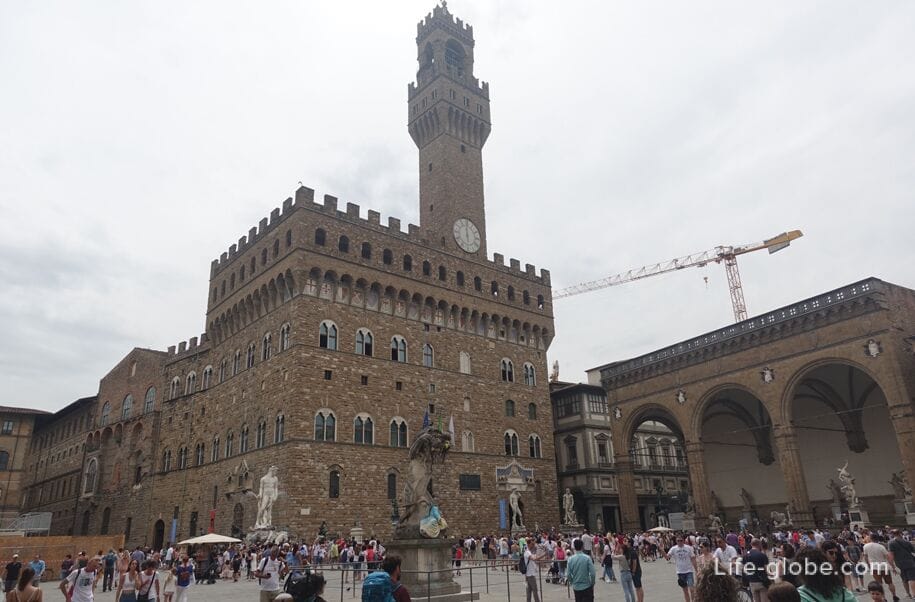
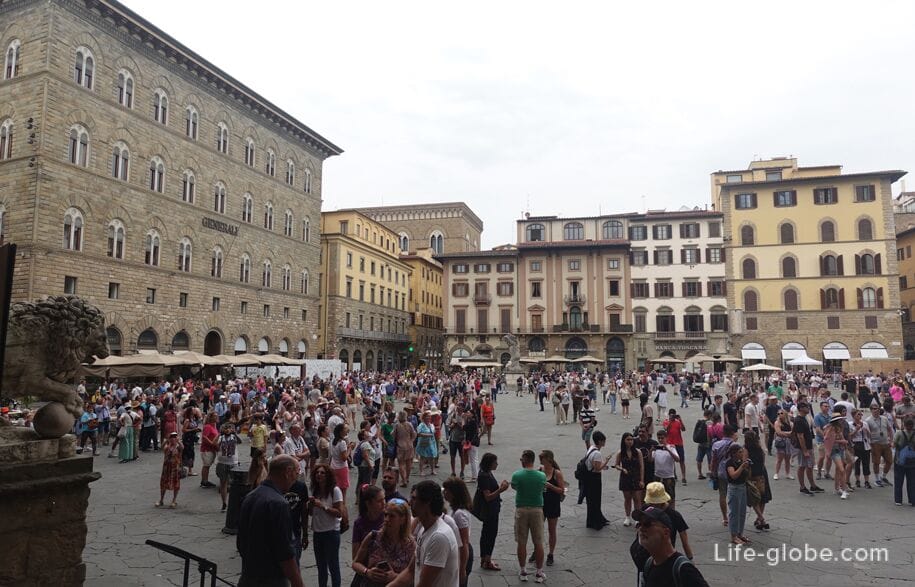
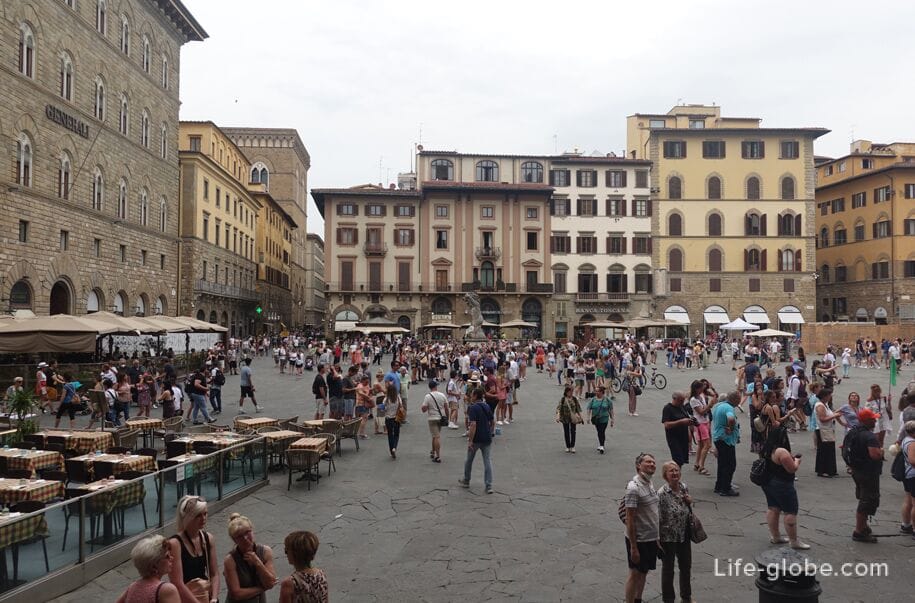
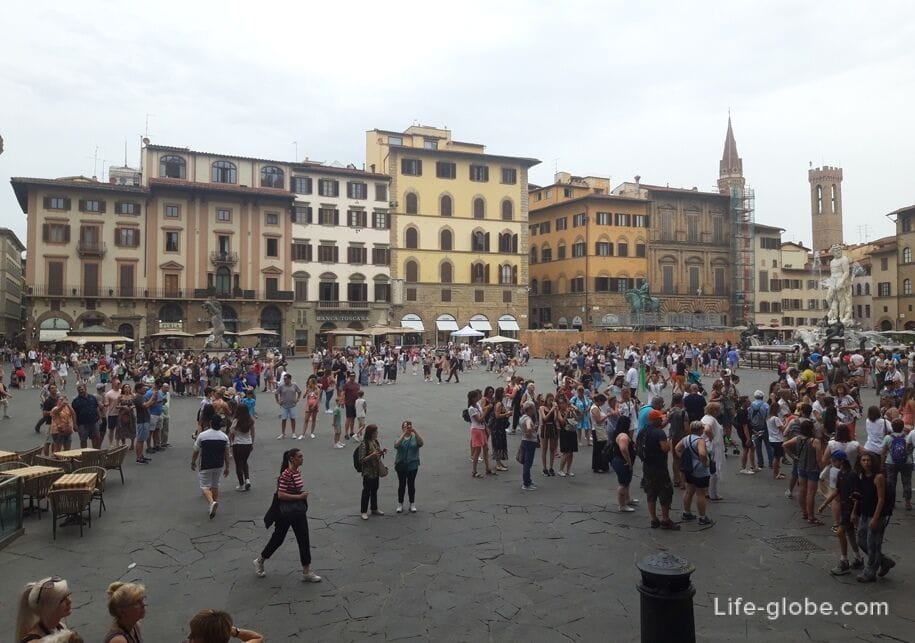
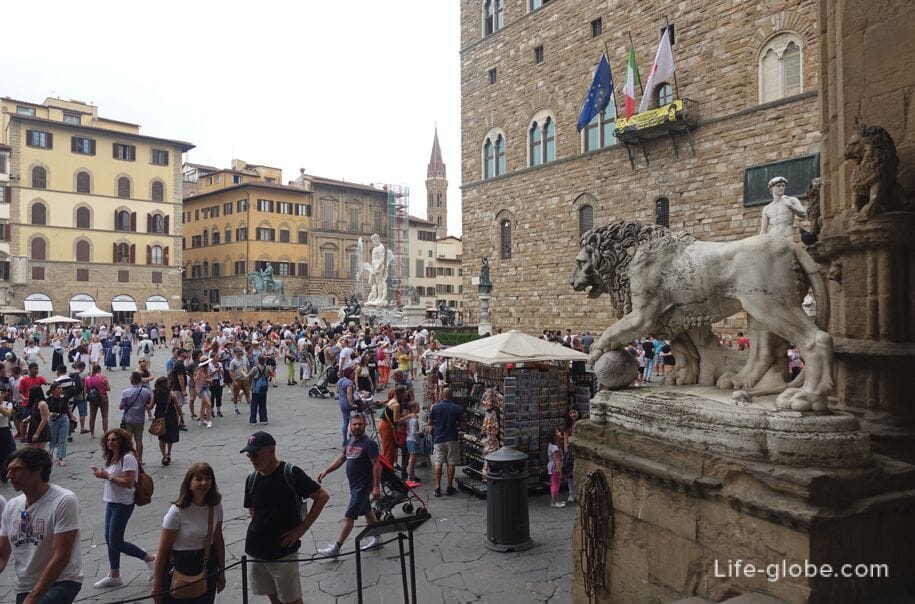
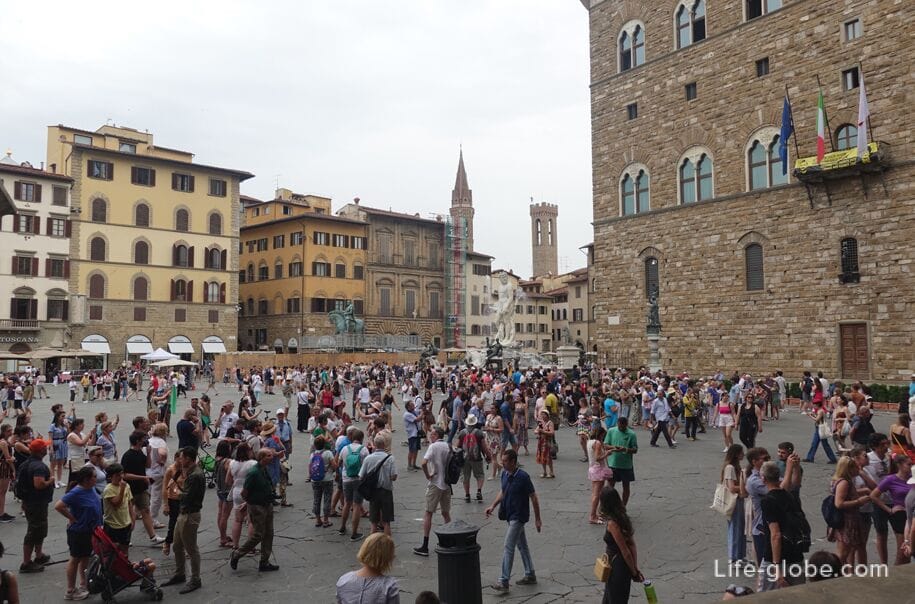

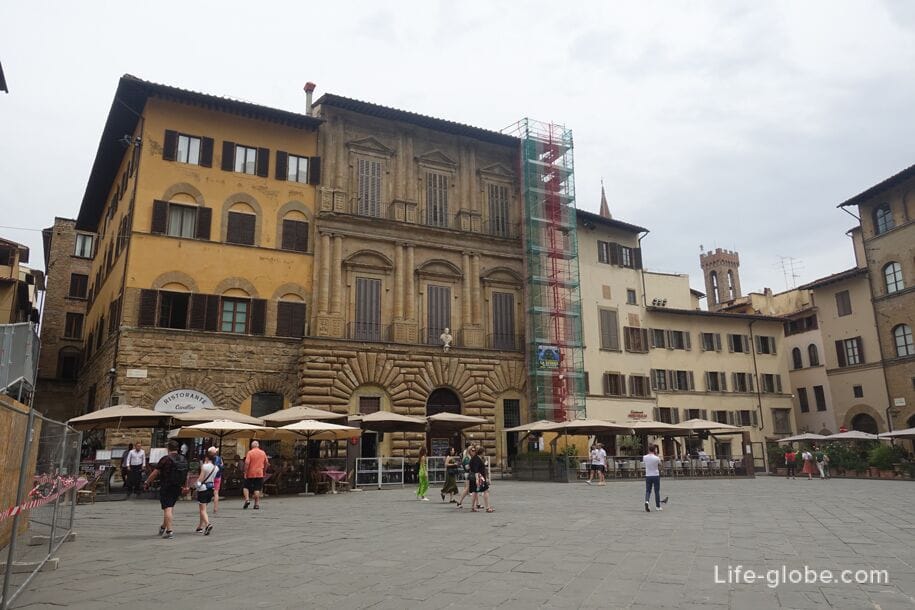
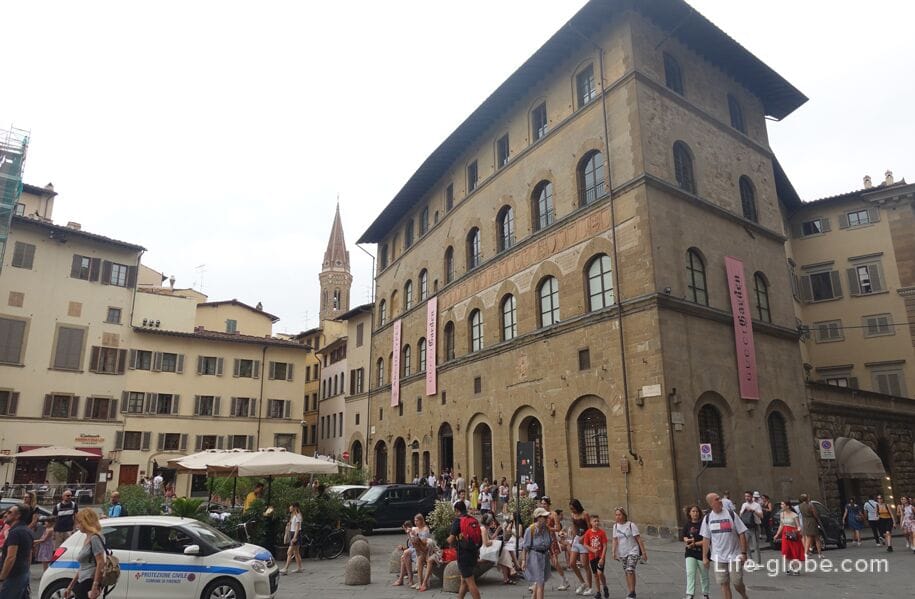
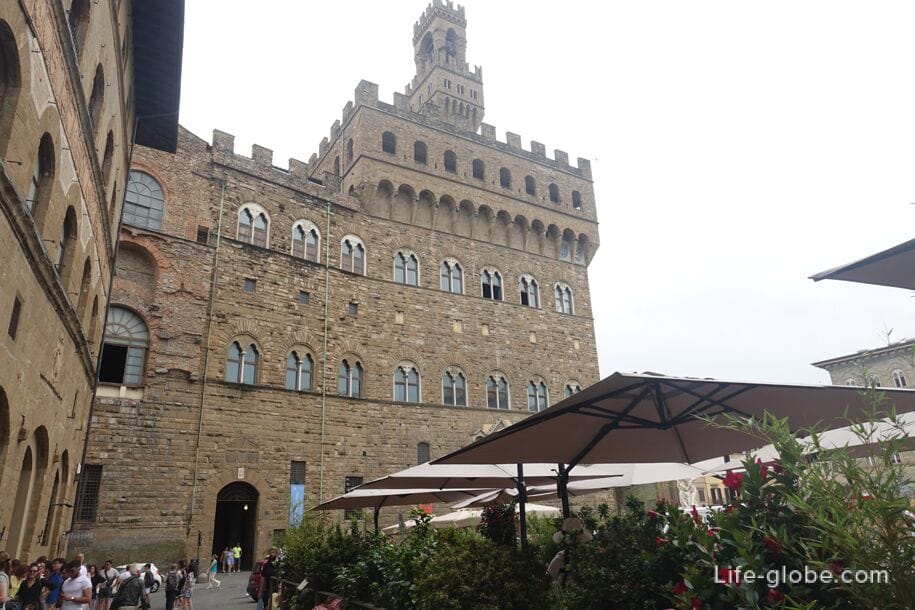
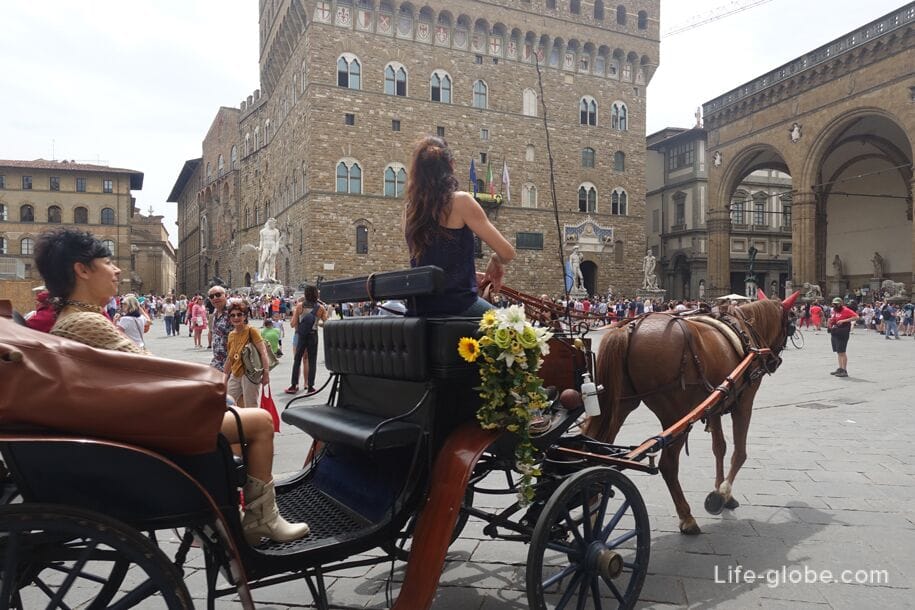
The main building on the Piazza della Signoria is the Palazzo Vecchio (which translates as "Old Palace") - the Town Hall of Florence, one of the most important and famous buildings of the city.
The old palace was built in 1299-1314 by the Italian architect and sculptor Arnolfo di Cambio. Then the palace was known as the Palazzo della Signoria, from which the square got its name.
During the history of the palazzo was modernized and expanded.
Although today most of the Palazzo Vecchio is a museum, but it also remains a symbol and center of local government - it houses the office of the Mayor of Florence, as well as the city council.
Externally, Palazzo Vecchio looks like a small fortified castle, which is facilitated by strict powerful features, rows of window openings, heraldic symbols in niches and a gallery crowned with battlements, a belfry and an Arnolfo tower, which enhances the appearance of the entire structure.
The main entrance to the palace is framed by two sculptures:
- on the left, a replica of Michelangelo's David, installed in 1910. The original sculpture stood on this site from 1504 to 1873, after which it was moved to the Accademia Gallery in Florence (Accademia di Belle Arti di Firenze), where it is still on display to the public;
- on the right, the sculpture group "Hercules who defeated Cacus".
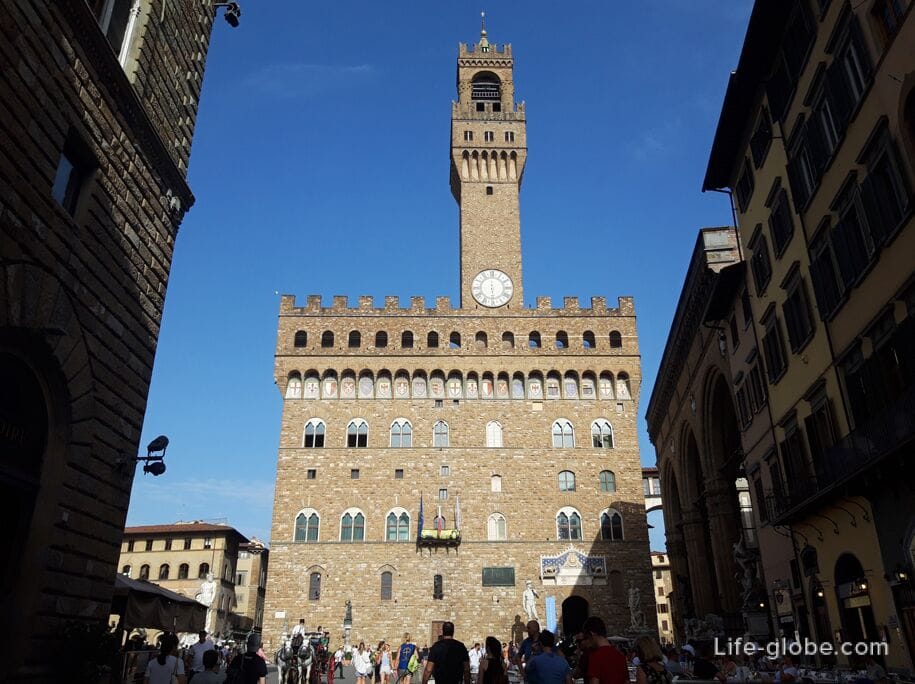
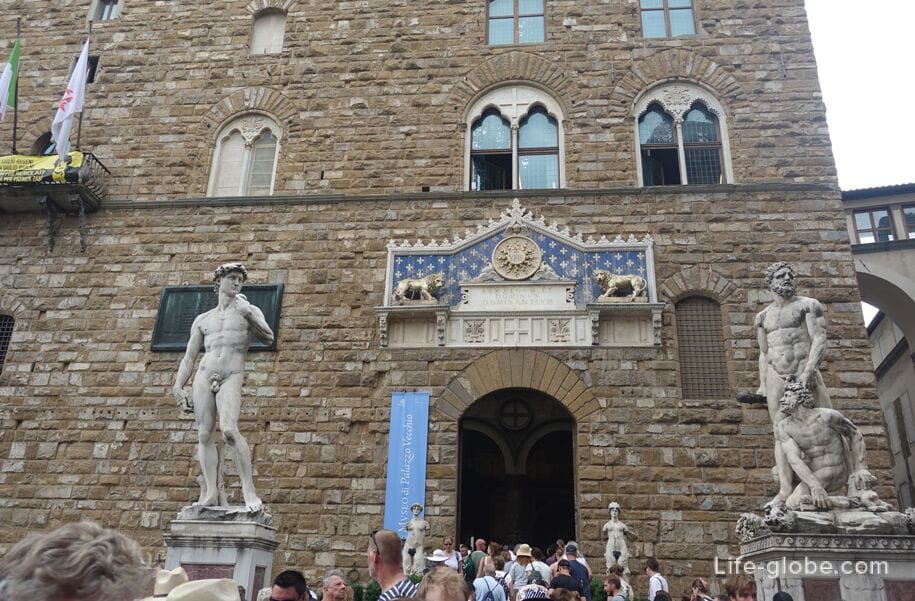
Today, the Vecchio Palace can be visited, there is a museum with courtyards and beautiful historical halls.
The Palazzo Vecchio tower, which is called the Arnolfo Tower, has a height of 95 meters and is named after its creator - Torre d'Arnolfo. Inside the tower, a stone staircase of 223 steps leads to the upper level of the crenellated observation deck, which offers panoramic views of the historic center of Florence. More about Palazzo Vecchio with a museum and a tower with an observation deck...
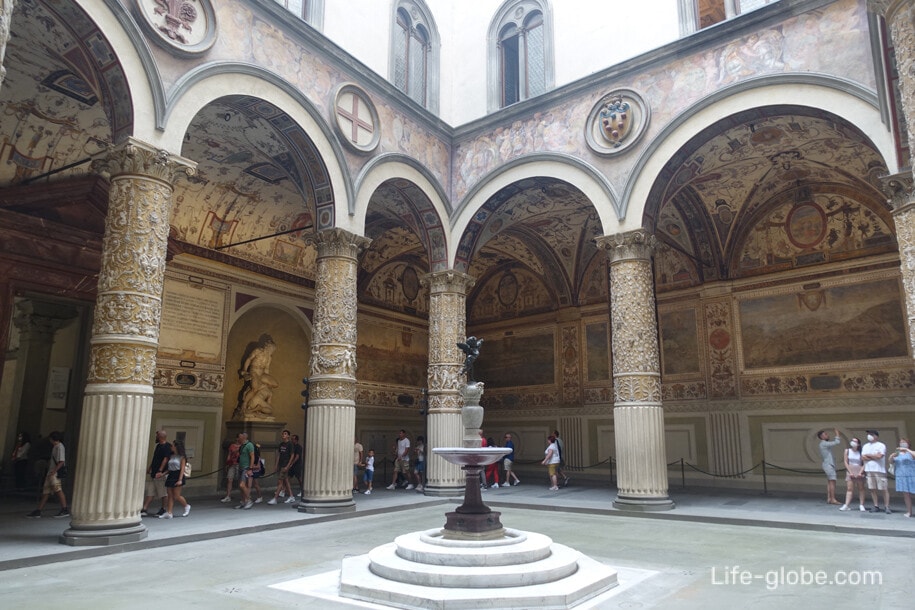
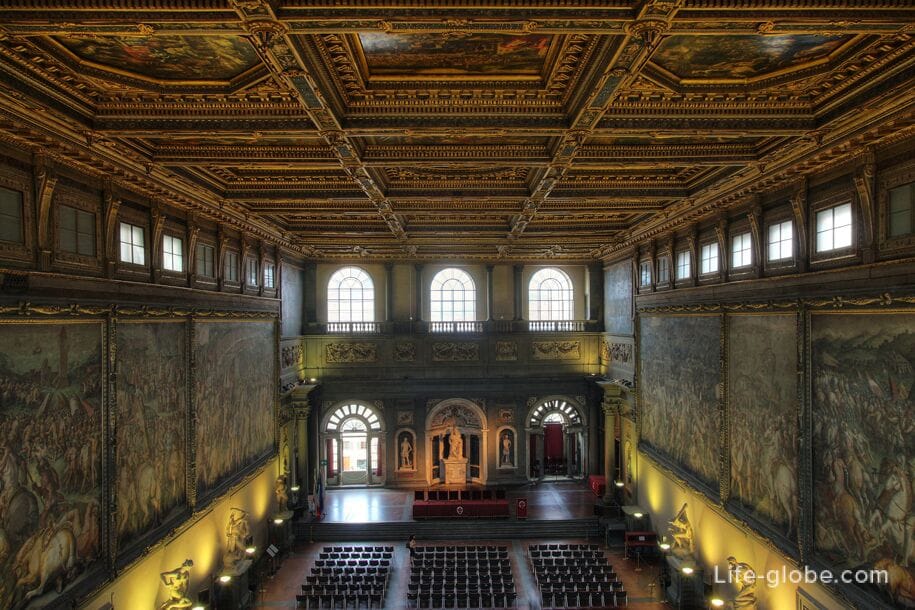

Near the Vecchio Palace on the Piazza della Signoria are:
- replica of the bronze statue of Judith with the head of Holofernes, originally created by Donatello between 1453 and 1457 (the original is kept in the Vecchio Palace);
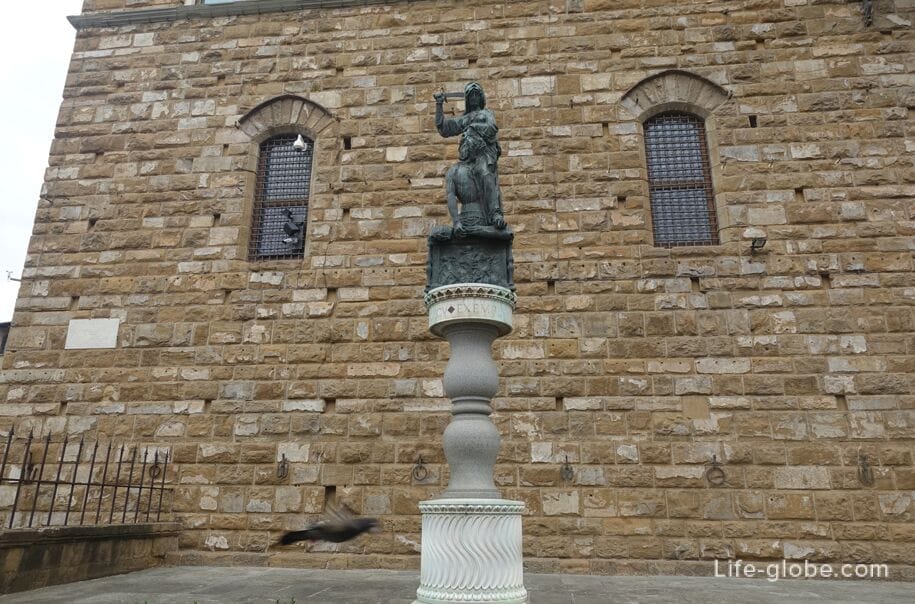
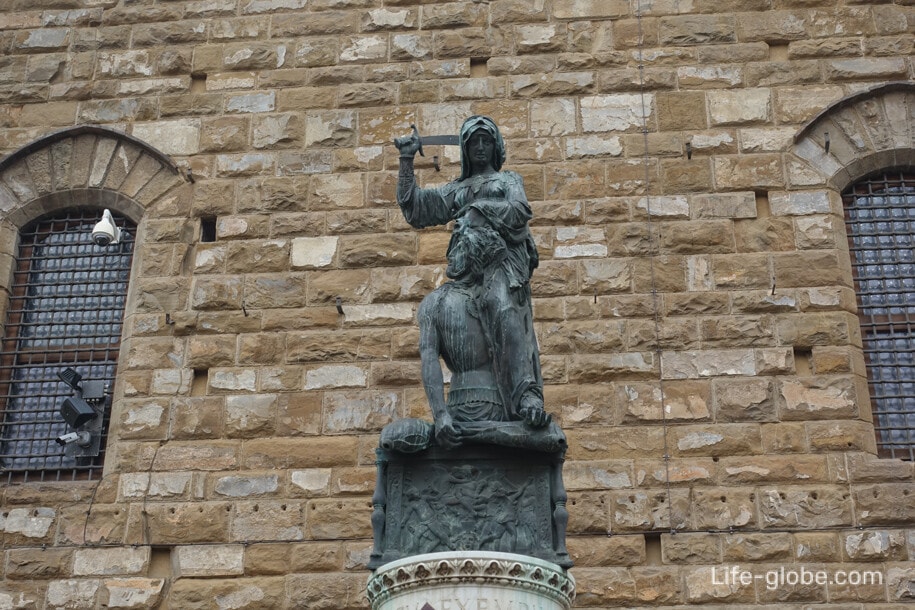
- replica of the Florentine lion sculpture - a symbol of people's power "Mordzocco" (or Marzocco) by Donatello from 1419-1420 (the original is in the Bargello Museum of Florence).
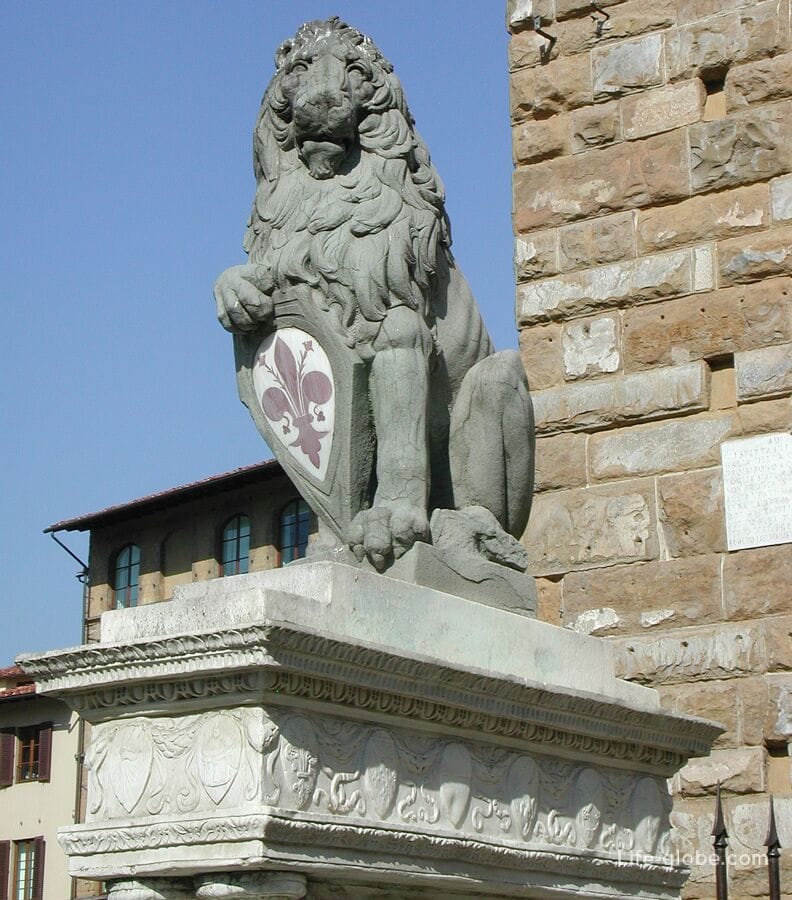
From the Palazzo Vecchio originates the Vasari Corridor (Corridoio Vasariano), which is an elevated covered gallery connecting the Palazzo Vecchio with the Palazzo Pitti on the other side of the Arno River.
The Vasari Corridor was built in 1565 by order of the Grand Duke of Tuscany Cosimo I de' Medici. The reason for the construction was the marriage of Cosimo's son, Francesco I de' Medici, with Joan of Austria. The idea of the construction was dictated by the Duke's desire to move freely between his residence and the government palace, since at that time the duke, like most monarchs, felt insecure on public streets.
The architect of the corridor was Giorgio Vasari. More about the Vasari Corridor…
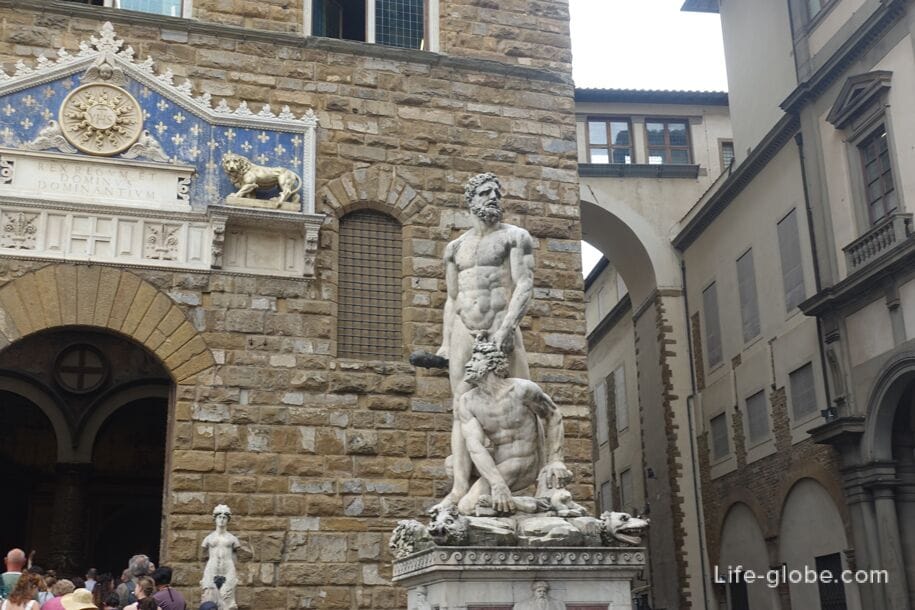
Another outstanding object of the Piazza della Signoria is the Loggia of Lanzi (Loggia dei Lanzi) or Loggia of the Signoria (Loggia della Signoria), which is an open gallery on both sides with an arcade on columns, and which houses valuable sculptures from the collection of the Uffizi Gallery, including the Medici lions, Cellini's Perseus and The Abduction of the Sabines" the works of Giambologna.
The loggia was built between 1376 and 1382 by Benci di Chione and Simone di Francesco Talenti, possibly designed by Jacopo di Sione. The loggia was intended to house popular gatherings and conduct public ceremonies, such as the swearing-in of gonfaloniers and priors.
There is a cafe on the roof of the loggia, which offers views of Piazza della Signoria. More about the Lanzi Loggia and sculptures…
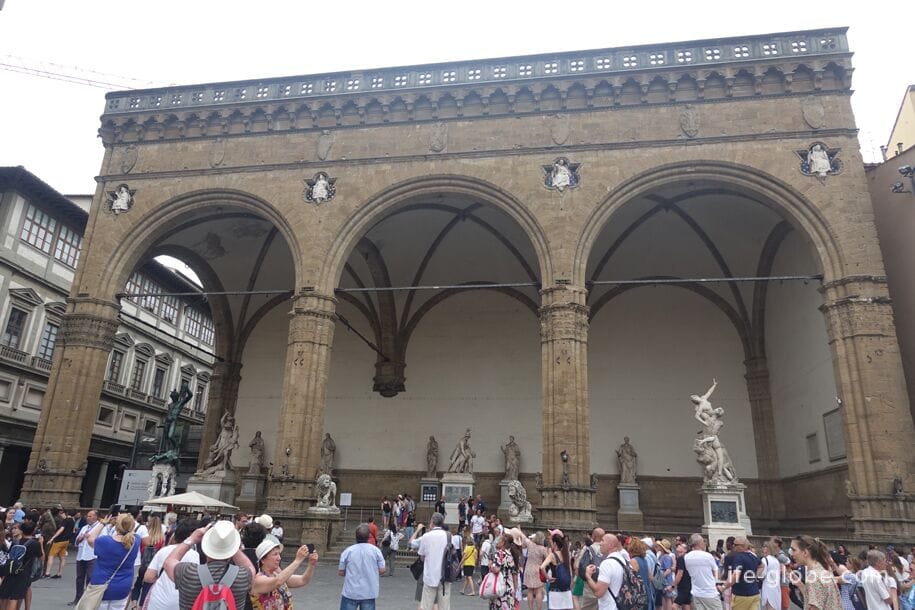

The back of the Lanzi loggia adjoins the Uffizi Gallery (Galleria degli Uffizi), into the courtyard of which there is a passage from the Piazza della Signoria.
The Uffizi Gallery is located in a historic building, the construction of which was started in 1560 as a magistracy commissioned by Cosimo I de' Medici, to house the "Uffizi", that is, the administrative and judicial institutions of Florence. The plans of the building were developed by the Italian architect and artist Giorgio Vasari.
Today, the Uffizi Gallery is an art museum, which is one of the most important in Italy, and which houses a collection of priceless works, especially from the Italian Renaissance period. More about the Uffizi Gallery…
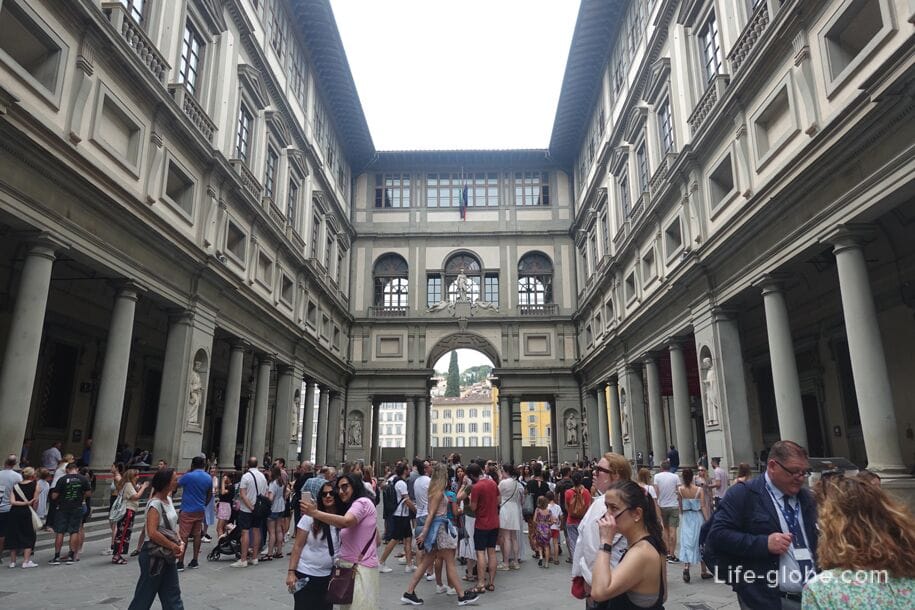
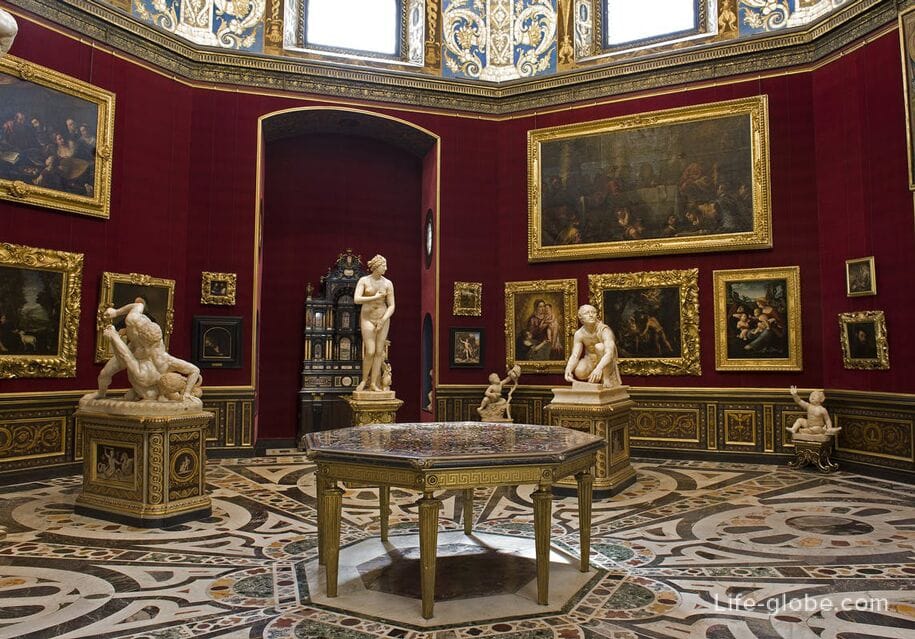
The Piazza della Signoria is decorated with a beautiful monumental fountain of Neptune or Fountain of Neptune (Fontana del Nettuno), which is one of the main in Florence and has sculptural decorations.
The fountain was created between 1560 and 1574 by order of Grand Duke Cosimo I de' Medici in honor of the wedding of his son Francesco de' Medici I and Grand Duchess Joanna of Austria. The fountain was designed by Baccio Bandinelli, and created by Bartolomeo Ammannati and several other artists.
During its history, the fountain has undergone modernization and restoration.
The fountain is made of bronze and marble and includes a number of mythological figures and iconographs that symbolize both the power of Cosimo I de' Medici and the union of Francesco and Joanna.
The central figure of the fountain is a large marble statue of Neptune standing on a horse-drawn chariot in the shape of a shell. Contemporaries noted that Neptune's face resembled that of Cosimo I. More about the Neptune Fountain…
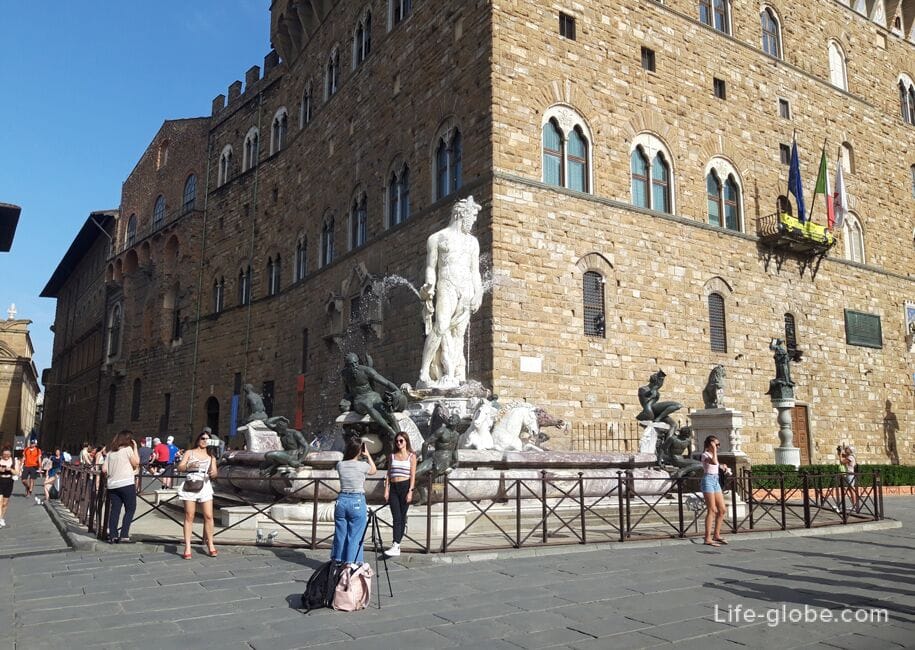
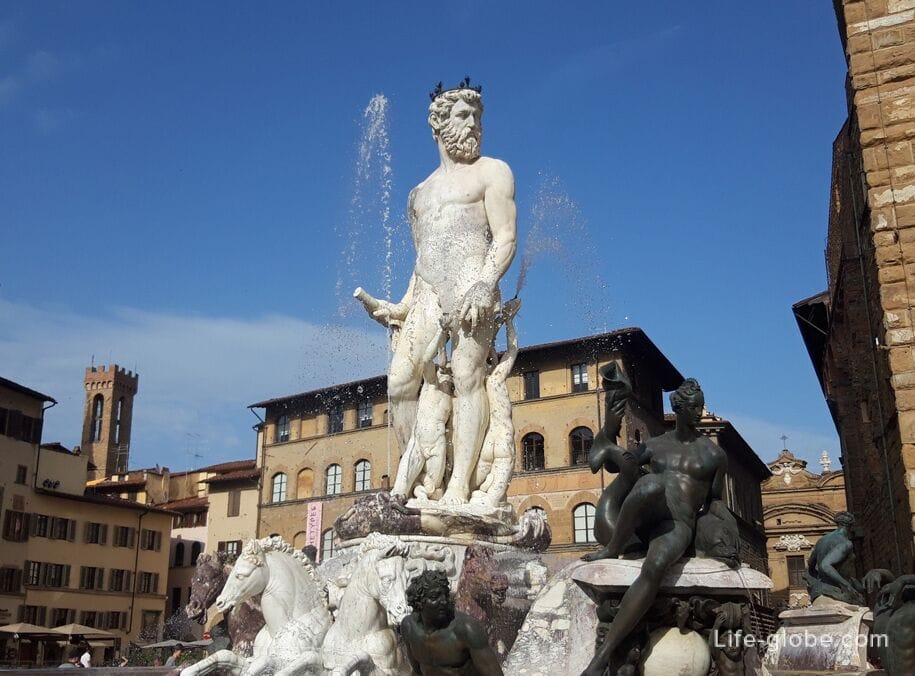
Not far from the Fountain of Neptune, the equestrian statue of Cosimo I de' Medici, commissioned in 1587 by Ferdinando I de' Medici in honor of his father, who was the first Grand Duke of Tuscany, is noteworthy.
The statue was created by the most famous sculptor in Florence at the time, Giambologna. The grandiose project was the first major equestrian sculpture created in Florence.
The bronze monument is mounted on a high marble pedestal, on which are placed three bas-reliefs depicting characteristic episodes from the life of Cosimo I: the election as duke (occurred in 1537), the conquest of Siena (in 1555) and the assignment of the title of Grand Duke (1569); also on the pedestal are depicted Capricorns, the symbol of Cosimo himself, as a figure masculinity, splendor and a symbol of the leader, and as the main star in the constellation of the Charioteer is associated with Amalthea and, consequently, with the "goat"; on the eastern side, a Latin inscription carved from bronze glorifies the exploits of Cosimo I.
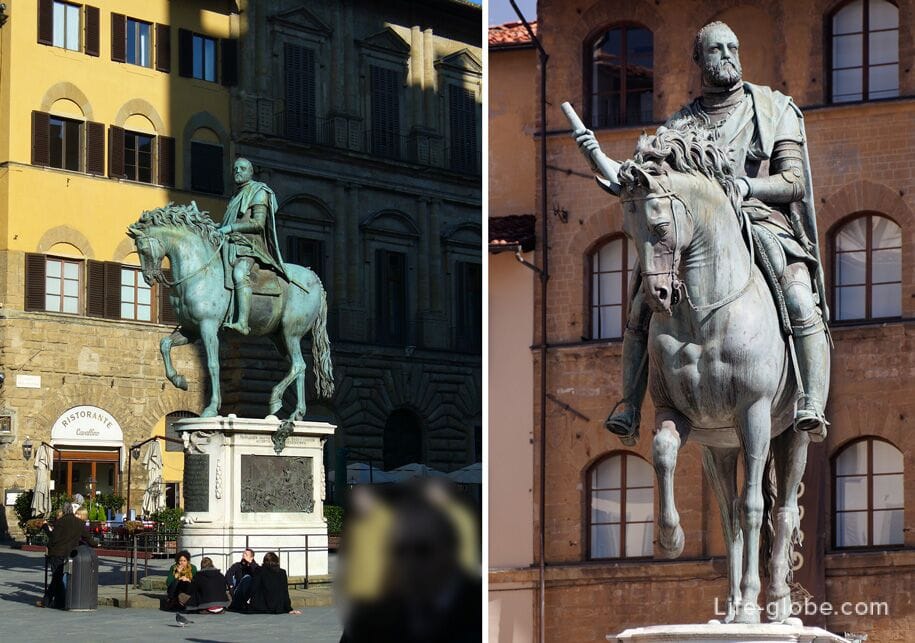
The Piazza della Signoria is decorated with another monument - a statue of a Ferocious lion (Il leone rampante) by Francesco Vezzoli.
The lion crushes in its mouth the Roman head of the second century AD, in stylization between different artistic periods, which should remind that art is eternal and recreate the fragments of a lost civilization. The monument is installed on an ancient foundation.
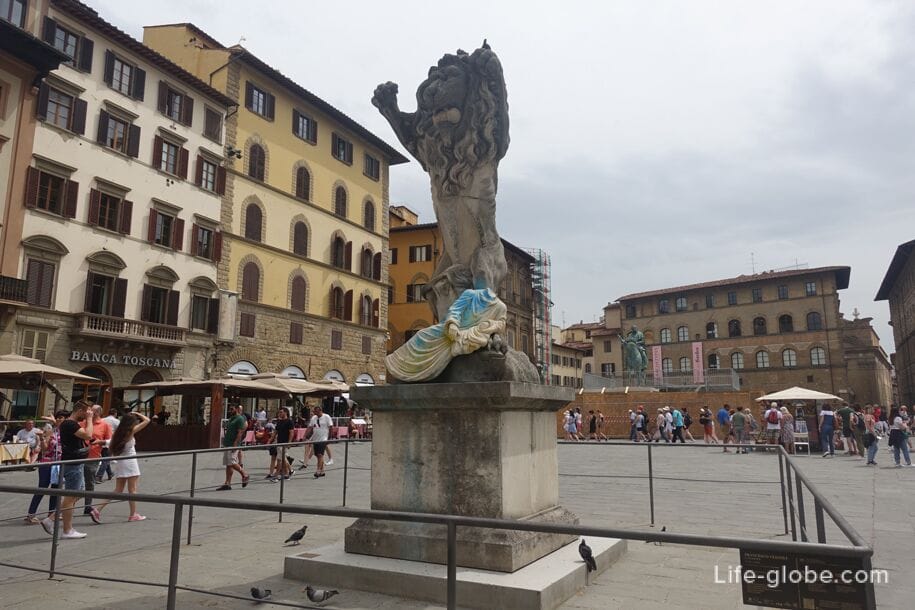
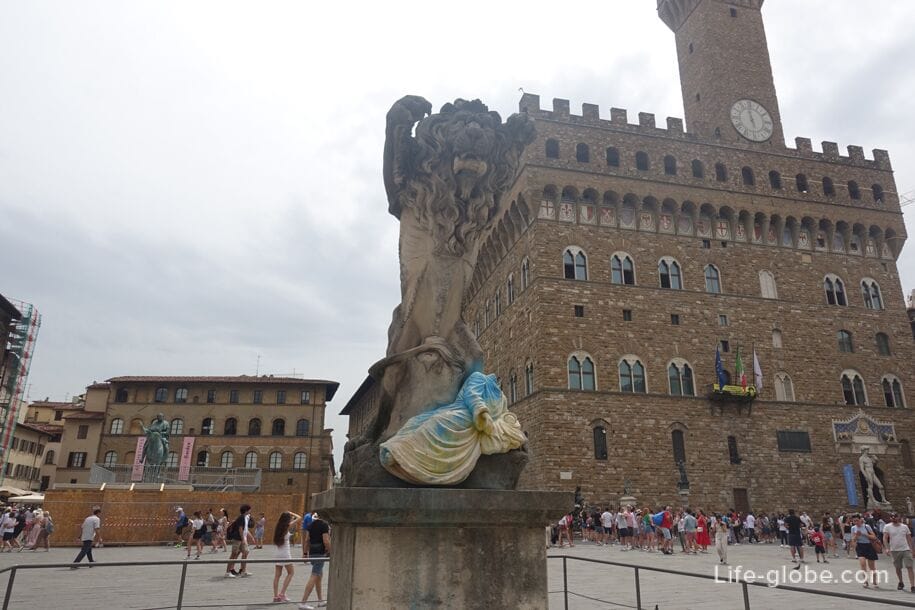
Other significant buildings in Piazza della SignoriaThe Commercial Court Palace or Commercial Court (Tribunale della Mercanzia), built in 1359 on the site of the Roman Theater to house the headquarters of the Merchant Court.
This institute had the function of resolving disputes between various arts guilds and between members of individual arts.
The palace was restored in 1905.
On the facade at the top of the building there are copies of the coats of arms of the Florentine guilds of arts.
Today the building houses the Gucci Museum.

Uguccioni Palace (Palazzo Uguccioni), having a Renaissance style and built for Giovanni Uguccioni since 1550.
The design of the palace was attributed to Raphael Sanzio da Urbino, Michelangelo, Bartolomeo Ammannati and Raffaello da Montelupo.
The first floor of the building stands out with hewn stone with arched portal and windows. The two upper floors have balconies and are decorated with Ionic and Corinthian semi-columns. On the high bases of the columns, family insignia and family coats of arms are carved: an anchor and a ladder, a kind of double rake, which, according to tradition, represent the ladder by which Uguccioni, therefore nicknamed Scalandroni, attacked the walls of the enemy. Above the front door of the house there is a bust of Francesco I de' Medici, by Giovanni Bandini, but once attributed to Giambologna, put by Benedetto Uguccioni, Giovanni's brother and heir, as a sign of devotion to the Grand Duke.
Today the building houses: Apartments Charme&Suite - Piazza Signoria and apartments Signoria apartment.
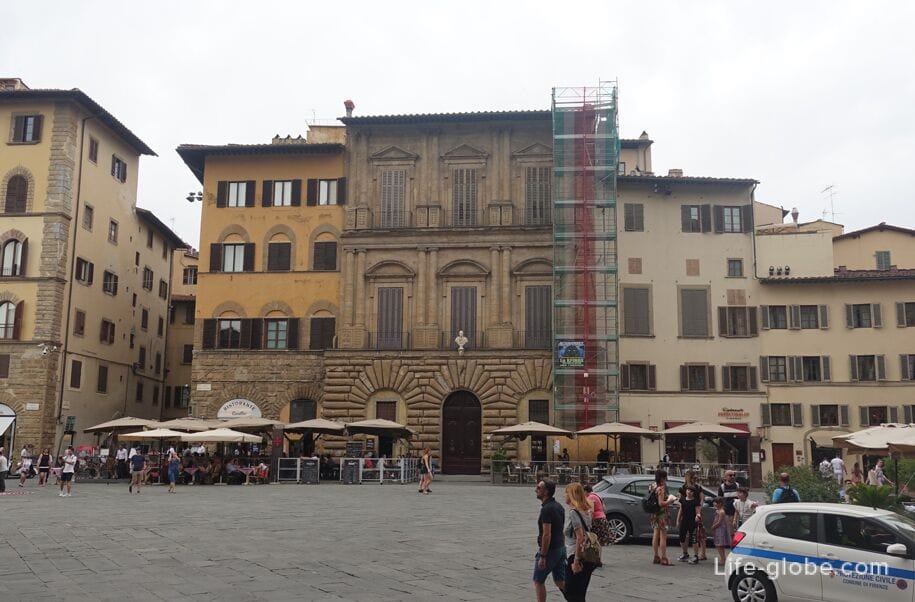
The Palazzo delle Assicurazioni Generali (Palazzo Lavison), built by order of the landowner Baron Edoardo Lavison in 1871 in the Neo-Renaissance style by architect Landi.
The architecture of the palace echoes the forms of the residences of the great Florentine Renaissance families (Medici, Strozzi and Gondi), but, due to the need for time during construction, the building has four floors instead of the usual three. Another unusual feature of that time is the cornice, made in a typical Roman style, but made of cast iron.
The first floor of the building is distinguished by open arches and is used for commercial purposes.
In the building, among other things, there is a historical cafe-confectionery "Rivoire".
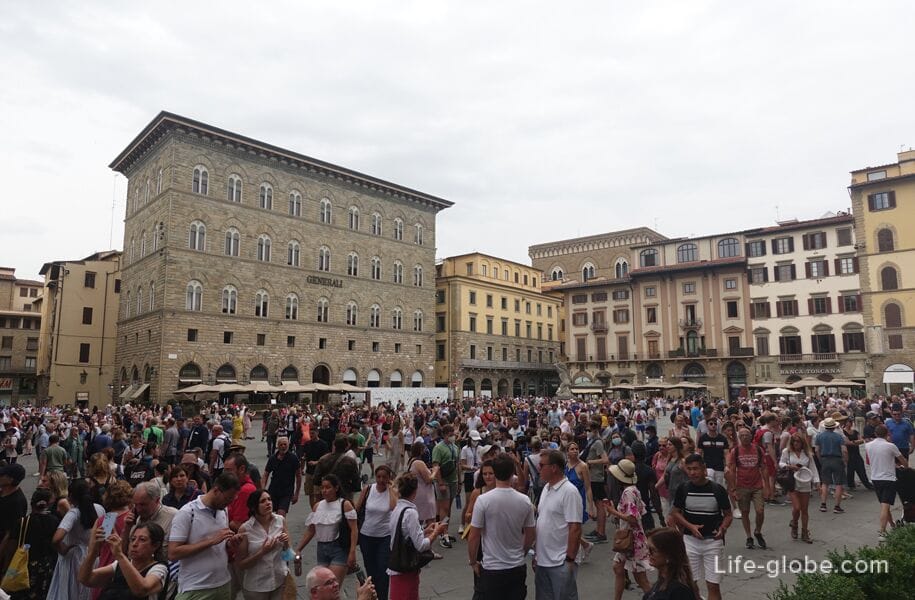
The Palazzo e case dei Guidacci (Palazzo e case dei Guidacci), also known as "della Meridiana", are civil buildings, on the facade of which a sundial is notable - an astronomical instrument dating from the first half of the 19th century and consisting of a large carved marble dial and a metal gnomon, which simultaneously points to the during the whole time months of the year - the average noon, set by the Greenwich meridian, and conditional, referring to the local time zone.

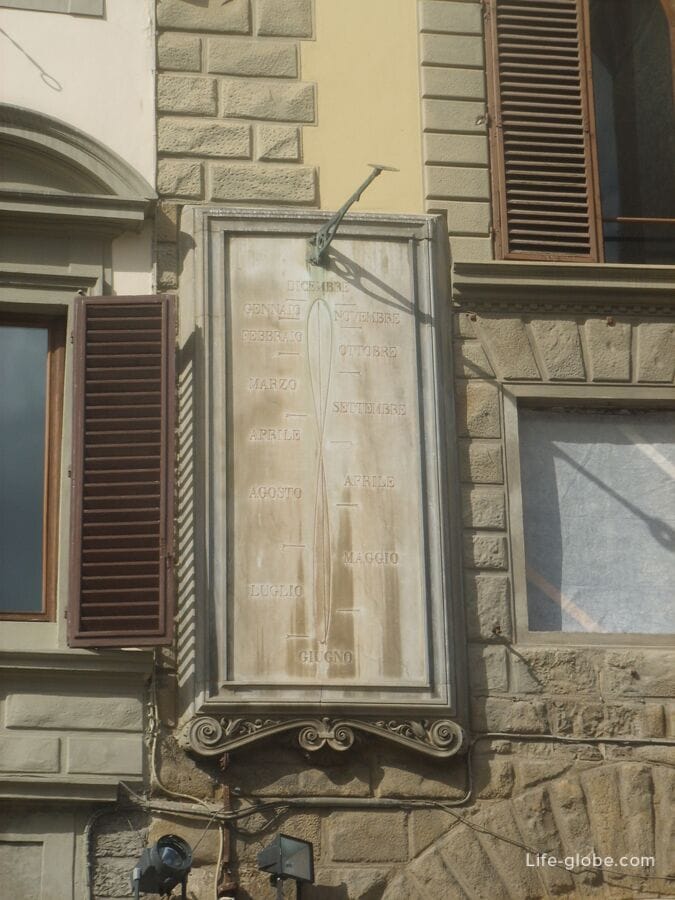
Remark! Free drinking fountains are located in the northern wall of the Palazzo Vecchio (landmark - Via dei Gondi). Non-carbonated water - the right fountain, carbonated water - the left.
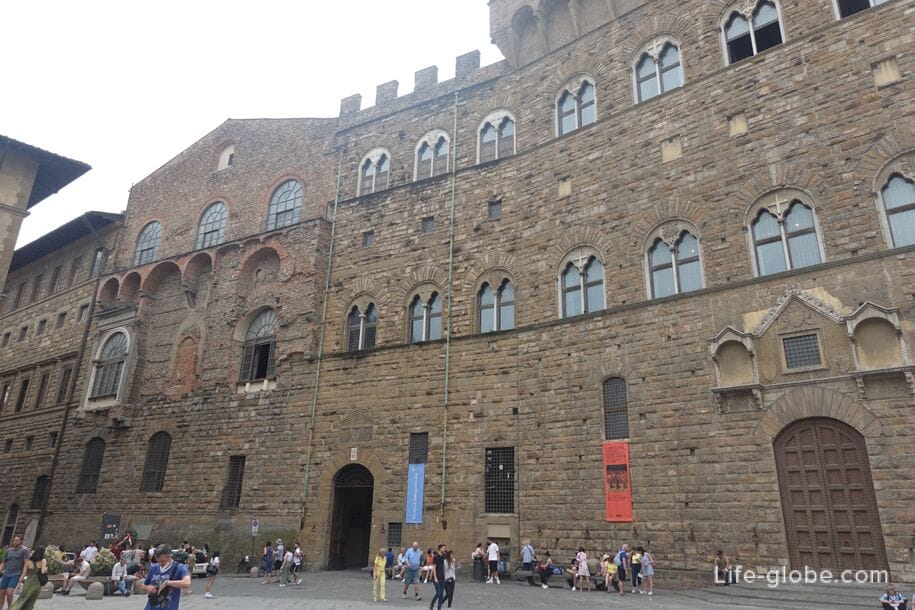
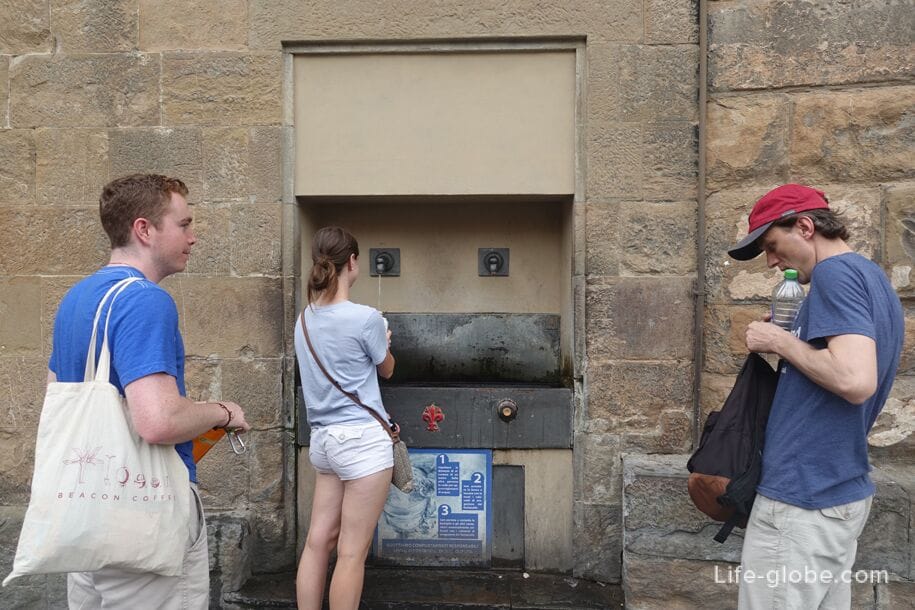
Coordinates of Piazza della Signoria in Florence: 43°46'11.0"N 11°15'20.0"E (43.769722, 11.255556).
All accommodation facilities in Florence (hotels, apartments, guest houses, etc.), including in the historical center of the city, in Piazza della Signoria and more remotely from those, can be viewed and booked here




